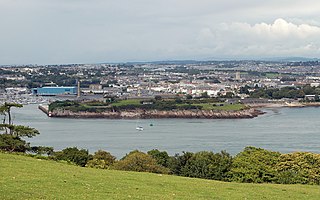
East Stonehouse was one of three towns that were amalgamated into modern-day Plymouth. West Stonehouse was a village that is within the current Mount Edgcumbe Country Park in Cornwall. It was destroyed by the French in 1350. The terminology used in this article refers to the settlement of East Stonehouse which is on the Devon side of the mouth of the Tamar estuary, and will be referred to as Stonehouse.
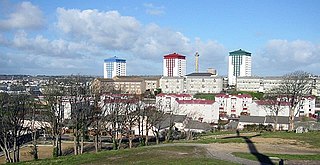
Devonport, formerly named Plymouth Dock or just Dock, is a district of Plymouth in the English county of Devon, although it was, at one time, the more important settlement. It became a county borough in 1889. Devonport was originally one of the "Three Towns" ; these merged in 1914 to form what would become in 1928 the City of Plymouth. It is represented in the Parliament of the United Kingdom as part of the Plymouth Sutton and Devonport constituency. Its elected Member of Parliament (MP) is Luke Pollard, who is a member of the Labour Party. The population of the ward at the 2011 census was 14,788.

Thornbury is a small village and civil parish in the local government district of Torridge, Devon, England. The parish, which lies about five miles (8 km) north-east of the town of Holsworthy, comprises the five hamlets of Thornbury, Woodacott, Brendon, Lashbrook and South Wonford. These five hamlets are spread over an area of some 6 square miles (16 km2), with a distance of three miles (5 km) from Brendon to Thornbury Church. Hence, the community is quite widespread, with the only focal point being the Green at Woodacott Cross. The parish is surrounded clockwise from the north by the parishes of Milton Damerel, Bradford, Cookbury and Holsworthy Hamlets. In 2011, its population was 290, in 120 households, little changed from the 291 residents it had in 1901.

Devonport High School for Boys is an 11–18 boys grammar school and academy in Plymouth, Devon, England. It has around 1,150 boys, and its catchment area includes southwest Devon and southeast Cornwall as well as Plymouth. Pupils are accepted on the basis of academic aptitude.

James Piers St Aubyn, often referred to as J P St Aubyn, was an English architect of the Victorian era, known for his church architecture and confident restorations.

Berry Pomeroy is a village and civil parish in the South Hams district of Devon, England, 2 miles (3 km) east of the town of Totnes. The parish is surrounded clockwise from the north by the parishes of Ipplepen, Marldon, Torbay, Stoke Gabriel, Ashprington, Totnes, and Littlehempston. In 2001 its population was 973, down from 1193 in 1901. The main road access is via the A385 road between Paignton and Totnes that runs through the parish, south of the village.
Weston Mill is a district in the ward of Ham, which is part of the City of Plymouth, Devon, England. It consists of two parts Weston Mill Village which was first mentioned in the Domesday Book in 1155 and the other part which dates to the Victorian period, they are separated by Weston Mill Hill, which is the only street with this name. It shares its borders with Ham Woods Nature Reserve, King's Tamerton, St. Budeaux and Camels Head. The area derived its name from being the mill belonging to the tithing, Geoffrey de Weston. It is situated close to the major naval base Devonport Dockyard, and the majority of the housing in the area is privately owned. The A3064 'St. Budeaux Bypass' also runs through the area. Together with King's Tamerton the area's population in the 2001 census, was 4,647, of which 50.2 per cent were male and 49.8 per cent were female.
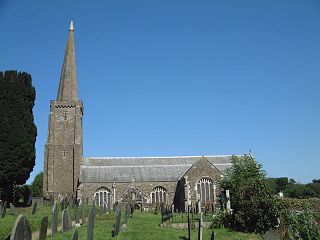
Holbeton is a civil parish and village located 9 miles south east of Plymouth in the South Hams district of Devon, England. At the 2001 census the parish had a population of 579, down from 850 in 1901. By 2011 it had increased to 619.
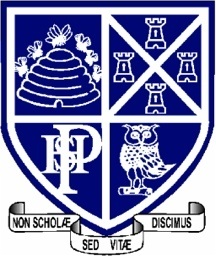
Plymouth High School for Girls (PHSG) is a girls' grammar school founded in 1874. It is located on St Lawrence Road in Plymouth, Devon, England, close to Mutley Plain and Plymouth city centre.

John Foulston was an English architect who was a pupil of Thomas Hardwick and set up a practice in London in 1796. In 1810 he won a competition to design the Royal Hotel and Theatre group of buildings in Plymouth, Devon, and after relocating he remained Plymouth's leading architect for twenty-five years.

Sutcombe is a village and civil parish in the local government district of Torridge, Devon, England. The parish, which lies about 5.5 miles north of the town of Holsworthy, is surrounded clockwise from the north by the parishes of West Putford, Abbots Bickington, Milton Damerel, Holsworthy Hamlets and Bradworthy. In 2001 its population was 299, compared to 351 in 1901.

Plymouth Athenaeum, located in Plymouth, England, is a society dedicated to the promotion of learning in the fields of science, technology, literature and art.

Sharpham is an historic estate in the parish of Ashprington, Devon. The Georgian mansion house, known as Sharpham House, overlooks the River Dart and is a Grade I listed building. The house was commenced in about 1770 by the Royal Navy captain Philemon Pownoll to the designs of the architect Sir Robert Taylor (1714–1788). In the opinion of Nikolaus Pevsner it contains "one of the most spectacular and daring later 18th century staircase designs anywhere in England". The park and gardens are Grade II* listed in the National Register of Historic Parks and Gardens. Part of the descent of Sharpham is shown on the Palmes family heraldic pedigree roll.

Sacred Heart Church is a Roman Catholic Parish church in Exeter, Devon, England. It is a part of the Roman Catholic Diocese of Plymouth. It was built from 1883 to 1884 and designed by Leonard Stokes. It is situated on the corner of South Street and Bear Street, close to Exeter Cathedral in the centre of the city. It is a Gothic Revival church and a Grade II listed building.
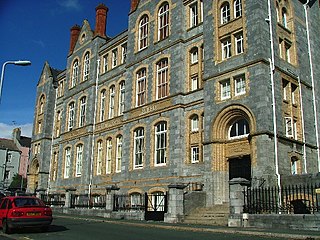
Sutton High School for Boys was a grammar school in Sutton, Plymouth, Devon, England, from 1926 to 1986. It was evacuated to St Austell, Cornwall, during World War II.

Sydenham Damerel, previously South Sydenham, is a village, parish and former manor in Devon, situated 4 miles north-west of Tavistock.
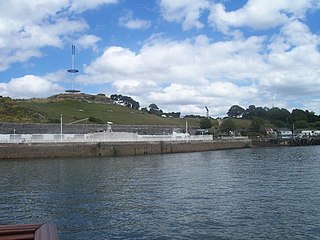
Mount Wise is a historic estate situated within the historic parish and manor of Devonport and situated about one mile west of the historic centre of the city of Plymouth, Devon. It occupies "a striking waterfront location" with views across Plymouth Sound to Mount Edgcumbe and the English Channel. Until 2004 it was a headquarters for senior Admiralty staff and was inaccessible to the public.

Radford in the parish of Plymstock in Devon is a historic manor and the oldest recorded seat of the prominent Harris family. It is today a low-cost housing suburb of the City of Plymouth. The 16th century manor house of the Harris family was remodelled in the 18th century and was demolished in 1937. However, various traces of the estate remain, including most notably the deerpark, now a public amenity known as Radford Park, with its large lake, an early 19th century gate-lodge at the entrance drive to the former mansion house, with gatepiers, on Radford Park Road, a bridge and boathouse with follies of a sham castle and another sham-ruin.

Stoke Damerel Church, also known as the Church of St Andrew with St Luke, is a Church of England church in Stoke, Plymouth, Devon, England. Dating from the 15th century, the church has been Grade II* listed since 1954. In addition to its listed status, the northern churchyard gate piers are also Grade II listed, alongside two 19th-century tombs, one of which belongs to Captain Tobias Furneaux.


















